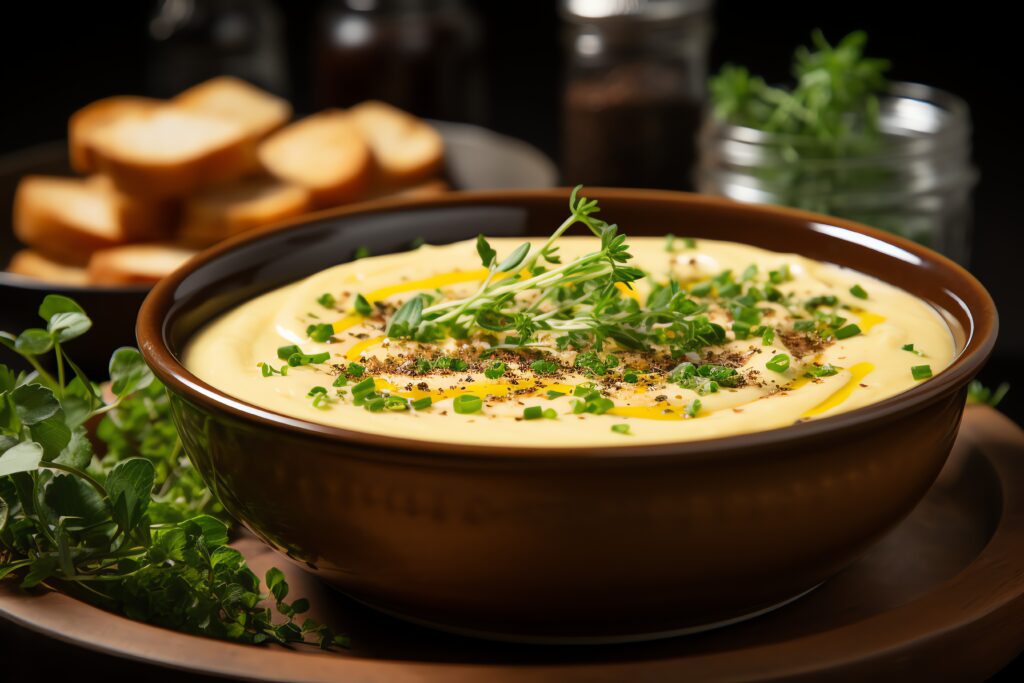
Greek Fava Dip: A Creamy Delight from the Aegean
Greek Fava Dip, a creamy and comforting dish made from yellow split peas, is a staple of Greek cuisine. Unlike its name suggests, it’s not made from fava beans but from yellow split peas, resulting in a smooth and flavourful dip. Chef Abdul, an expert in Mediterranean flavours, unveils the history, culinary uses, and secrets of preparing this iconic dip. With its velvety texture and earthy flavour, Greek Fava Dip embodies the simplicity and richness of Greek cooking.
The Origins of Muhammara
Muhammara’s roots are in the ancient city of Aleppo, which is famous for its culinary innovations and use of vibrant spices. The word “Muhammara” translates to “reddened” in Arabic, a nod to its signature deep red hue derived from roasted red peppers and Aleppo pepper flakes. Traditionally, Muhammara was crafted using locally grown ingredients, making it a dish that encapsulates the essence of its region.
Uses of Greek Fava Dip
- As a Dip: Traditionally served with crusty bread, pita, or raw vegetables for a light and healthy appetizer.
- As a Side Dish: Accompanies grilled meats, seafood, or roasted vegetables beautifully.
- As a Spread: Adds a creamy touch to sandwiches and wraps.
- In Mezze Platters: Complements other Mediterranean dips like hummus and tzatziki.
- As a Base: Used under sautéed onions, capers, or olives for an elevated presentation.
“Greek Fava Dip is versatile and easy to pair, making it a must-have for any Mediterranean-inspired meal,” says Chef Abdul.
Storing Greek Fava Dip
Greek Fava Dip can be stored in an airtight container in the refrigerator for up to three days. If the dip thickens, add a splash of warm water or olive oil and stir to restore its creamy texture. Chef Abdul advises serving it at room temperature for the best flavour.
Ingredients
- 250 grams of yellow split peas
- 1 medium onion, finely chopped
- 1 garlic clove, minced
- 3 tablespoons olive oil (plus extra for garnish)
- Juice of 1 lemon
- 1 teaspoon dried oregano
- Salt and pepper to taste
- Optional: Capers, red onion slices, or parsley for garnish
Method:
- Rinse the yellow split peas under cold water until the water clears.
- Heat 1 tablespoon of olive oil in a medium pot and sauté the onion and garlic until softened.
- Add the yellow split peas to the pot and enough water to cover them by about 2 inches. Bring to a boil, then reduce the heat and simmer for 30-40 minutes or until the peas are tender.
- Drain excess water and transfer the peas to a blender or food processor.
- Add olive oil, lemon juice, oregano, salt, and pepper. Blend until smooth and creamy.
- Adjust the seasoning to taste. Add warm water or olive oil to achieve the desired consistency if the dip is too thick.
- Transfer to a serving bowl, drizzle with olive oil, and garnish with capers, red onion slices, or parsley.
“The key to a great Greek Fava Dip is using fresh, high-quality olive oil and blending the dip until it’s luxuriously smooth,” Chef Abdul emphasizes.
Variations of Greek Fava Dip
- Spicy Kick: Add a pinch of red chilli flakes for a hint of heat.
- Herb-Infused: Incorporate fresh dill or mint for a fragrant twist.
- Garlicky Flavour: Increase the garlic for a stronger, more robust taste.
- Vegetable Topping: Top the dip with sautéed cherry tomatoes or caramelised onions for added texture and flavour.
- Seafood Pairing: Serve with grilled shrimp or calamari for a seafood-inspired dish.
Famous Restaurants Serving Greek Fava Dip
- To Psaraki, Santorini: Celebrated for its authentic Cycladic cuisine, including a standout Fava Dip.
- Kuzina, Athens: Known for its modern twists on traditional Greek dishes, including this classic dip.
- Mavro Provato, Athens: A favourite among locals for its fresh and flavourful Fava Dip.
- Avli Tou Thodori, Mykonos: Offers a luxurious take on Fava Dip as part of its mezze platters.
- Taverna Kyclades, New York: Renowned for bringing authentic Greek flavours to an international audience, including its creamy Fava Dip.
Conclusion
Greek Fava Dip beautifully captures the essence of Mediterranean simplicity and flavour. Chef Abdul’s recipe and insights provide an easy way to bring a taste of Greece to your table. Whether served as an appetizer, side dish, or part of a mezze spread, this creamy dip is a testament to the magic of humble ingredients.
As Chef Abdul puts it, “Greek Fava Dip is a reminder that the simplest dishes, made with care, can be the most memorable. It’s a dip that nourishes both the body and the soul.”

